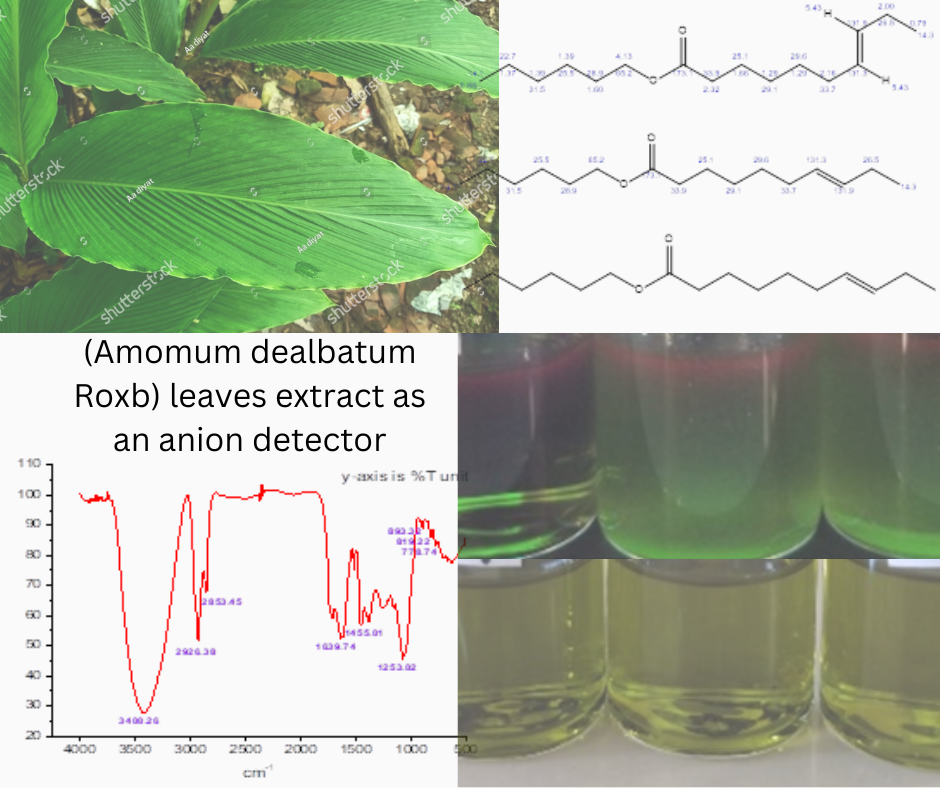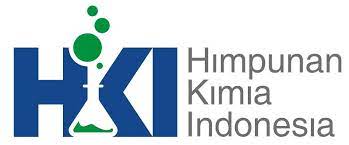
Characterization of methanol extract from Renggak (Amomum dealbatum Roxb) leaves and its application as an anion detector.
Authors
Najah Baroud , Syarifa Wahidah Al Idrus , R RahmawatiDOI:
10.29303/aca.v7i2.192Published:
2024-12-14Issue:
Vol. 7 No. 2 (2024)Keywords:
anion test, iodide anion, phosphate anion, renggak leafArticles
Downloads
How to Cite
Downloads
Metrics
Abstract
Renggak (Amomum dealbatum Roxb) shows significant potential as a natural resource with applications in various fields, particularly in environmental sensing. This capability positions Renggak as a promising candidate for developing eco-friendly chemosensors, contributing to improved monitoring of these critical anions in the environment and health. Additionally, its diverse phytochemical profile suggests potential uses in medicinal applications, further enhancing its value as a multifaceted plant. This research focuses on the characterization of the methanol extract from Renggak (Amomum dealbatum Roxb) leaves, and it's potential to detect iodide and phosphate anions. The extraction process involved soaking dried renggak leaves in methanol for 72 hours. Afterwards, the solution was filtered and evaporated, resulting in a paste-like extract. The extract was characterized using FTIR and GC-MS techniques, followed by testing its performance as a chemosensor. The paste extract was dissolved in methanol and mixed with a saturated solution of iodide and phosphate salts for the anion detection test. Then, 3 mL of each anion solution was combined with the extract, and any changes in the solution were observed. FTIR analysis revealed the presence of OH groups and C=O double bonds in the methanol extract. GC-MS analysis identified 20 compounds, with hexadecanoic acid and 9-octadecenoic acid being the most abundant. The extract demonstrated fluorescent properties in the anion detection test, acting as a chemosensor. When exposed to a UV lamp at 250 nm, the solution emitted a green fluorescent glow, indicating the successful detection of anions. These findings suggest that the methanol extract of renggak leaves could serve as an effective fluorescent chemosensor for iodide and phosphate anions.
References
Ishii, R., Mori, H., Matsumura, K., Hongo, N., Kiyosue, H., Matsumoto, S., Yoshimi, T., & Ujiie, S. (2012). Molecular interactions between anticancer drugs and iodinated contrast media: An in vitro spectroscopic study. Journal of Biomedical Science and Engineering, 05(01), 24–33. https://doi.org/10.4236/jbise.2012.51004
Sato, H., Morisawa, Y., Takaya, S., & Ozaki, Y. (2022). A Study of C=O…HO and OH…OH (Dimer, Trimer, and Oligomer) Hydrogen Bonding in a Poly(4-vinylphenol) 30%/Poly(methyl methacrylate) 70% Blend and its Thermal Behavior Using Near-Infrared Spectroscopy and Infrared Spectroscopy. Applied Spectroscopy, 76(7), 831–840. https://doi.org/10.1177/00037028221086913
Seki, T., Chiang, K.-Y., Yu, C.-C., Yu, X., Okuno, M., Hunger, J., Nagata, Y., & Bonn, M. (2020). The Bending Mode of Water: A Powerful Probe for Hydrogen Bond Structure of Aqueous Systems. The Journal of Physical Chemistry Letters, 11(19), 8459–8469. https://doi.org/10.1021/acs.jpclett.0c01259
Hansen, P. E., Vakili, M., Kamounah, F. S., & Spanget-Larsen, J. (2021). NH Stretching Frequencies of Intramolecularly Hydrogen-Bonded Systems: An Experimental and Theoretical Study. Molecules (Basel, Switzerland), 26(24). https://doi.org/10.3390/molecules26247651
V, K. D., Shanmugasundaram, R., & Mohan, V. R. (2012). Gc-Ms Analysis of Ethanol Extract of Entada Pursaetha Dc Seed. 3(1), 30–33.
Balamurugan, A., Evanjaline, M. R., B, P., & V R, M. (2018). GC-MS ANALYSIS OF BIOACTIVE COMPOUNDS FROM THE ETHANOL EXTRACT OF LEAVES OF NEIBUHRIA APETALA DUNN. International Research Journal of Pharmacy, 8(12), 72–78. https://doi.org/10.7897/2230-8407.0812253
Hasan, M. M., Mahmud, M. R. Al, & Islam, M. G. (2019). GC-MS Analysis of Bio-active Compounds in Ethanol Extract of Putranjiva roxburghii Wall. Fruit Peel. Pharmacognosy Journal, 11(1), 146–149. https://doi.org/10.5530/pj.2019.1.24
Ugwu, O. P.-C., Alum, E. U., Okon, M. Ben, Aja, P. M., Obeagu, E. I., & Onyeneke, E. C. (2023). Anti-nutritional and gas chromatography-mass spectrometry (GC-MS) analysis of ethanol root extract and fractions of Sphenocentrum jollyanum. RPS Pharmacy and Pharmacology Reports, 2(2). https://doi.org/10.1093/rpsppr/rqad007
Balabhaskar, R., & Vijayalakshmi, K. (2021). Identification of Secondary Metabolites from the Ethanol extract of the leaves of Bauhinia tomentosa by GC-MS Analysis. Research Journal of Pharmacy and Technology, 14(5), 2335–2341. https://doi.org/10.52711/0974-360X.2021.00482
Mangas Marín, R., Montes de Oca Porto, R., Herrera Paredes, M. E., Bello Alarcón, A., Hernández Balmaseda, I., Menéndez Soto del Valle, R., Paz Lopes, M. T., & Rodeiro Guerra, I. (2019). GC/MS analysis and bioactive properties of extracts obtained from Clusia minor L. leaves. Journal of the Mexican Chemical Society, 62(4). https://doi.org/10.29356/jmcs.v62i4.544
Rahmawati, R., Purwono, B., & Matsjeh, S. (2017). A Novel 4-(1H-Benzimidazol-2-yl)-2-methoxy-phenol Derived Fluorescent Sensor for Determination of CN– Ion. Asian Journal of Chemistry, 29(9), 1959–1962. https://doi.org/10.14233/ajchem.2017.20662
Ezhilan, B. P., & Neelamegam, R. (2012). GC-MS analysis of phytocomponents in the ethanol extract of Polygonum chinense L. Pharmacognosy Research, 4(1), 11–14. https://doi.org/10.4103/0974-8490.91028
Ho, H. A., & Leclerc, M. (2003). New Colorimetric and Fluorometric Chemosensor Based on a Cationic Polythiophene Derivative for Iodide-Specific Detection. Journal of the American Chemical Society, 125(15), 4412–4413. https://doi.org/10.1021/ja028765p
Lee, D. Y., Singh, N., Kim, M. J., & Jang, D. O. (2011). Chromogenic and Fluorescent Recognition of Iodide with a Benzimidazole-Based Tripodal Receptor. Organic Letters, 13(12), 3024–3027. https://doi.org/10.1021/ol2008846
Junaid, H. M., Waseem, M. T., Khan, Z. A., Munir, F., Sohail, S., Farooq, U., & Shahzad, S. A. (2022). Fluorenone-Based Fluorescent and Colorimetric Sensors for Selective Detection of I – Ions: Applications in HeLa Cell Imaging and Logic Gate. ACS Omega, 7(11), 9730–9742. https://doi.org/10.1021/acsomega.1c07279
Salomón-Flores, M. K., Hernández-Juárez, C. L., Bazany-Rodríguez, I. J., Barroso-Flores, J., Martínez-Otero, D., López-Arteaga, R., Valdés-Martínez, J., & Dorazco-González, A. (2019). Efficient fluorescent chemosensing of iodide based on a cationic meso-tetraarylporphyrin in pure water. Sensors and Actuators B: Chemical, 281, 462–470. https://doi.org/10.1016/j.snb.2018.10.127
Wang, X., Zhang, C., Feng, L., & Zhang, L. (2011). Screening iodide anion with selective fluorescent chemosensor. Sensors and Actuators B: Chemical, 156(1), 463–466. https://doi.org/10.1016/j.snb.2011.04.023
Saeed, M. A., Powell, D. R., & Hossain, M. A. (2010). Fluorescent detection of phosphate anion by a highly selective chemosensor in water. Tetrahedron Letters, 51(37), 4904–4907. https://doi.org/10.1016/j.tetlet.2010.07.078
Liao, J.-H., Chen, C.-T., & Fang, J.-M. (2002). A Novel Phosphate Chemosensor Utilizing Anion-Induced Fluorescence Change. Organic Letters, 4(4), 561–564. https://doi.org/10.1021/ol0171564
Huang, M.-X., Lai, J.-P., Sun, H., & Wu, W.-Z. (2019). A simple, highly selective and ultra-sensitive “off-on-off” fluorescent chemosensor for successive detection of aluminum ion and phosphate in water samples. Microchemical Journal, 151, 104195. https://doi.org/10.1016/j.microc.2019.104195
Li, L., Yu, S.-J., Zheng, R.-G., Li, P., Li, Q.-C., & Liu, J.-F. (2023). Removal of iodide anions in water by silver nanoparticles supported on polystyrene anion exchanger. Journal of Environmental Sciences, 128, 45–54. https://doi.org/10.1016/j.jes.2022.08.012
License
Copyright (c) 2024 Najah Baroud, Syarifa Wahidah Al Idrus, R Rahmawati

This work is licensed under a Creative Commons Attribution-NonCommercial-ShareAlike 4.0 International License.
Authors who publish with ACA: Acta Chimica Asiana agree to the following terms:
- Authors retain copyright and grant the journal right of first publication with the work simultaneously licensed under a Creative Commons Attribution-NonCommercial-ShareAlike 4.0 International License. This license allows authors to use all articles, data sets, graphics, and appendices in data mining applications, search engines, web sites, blogs, and other platforms by providing an appropriate reference. The journal allows the author(s) to hold the copyright without restrictions and will retain publishing rights without restrictions.
- Authors are able to enter into separate, additional contractual arrangements for the non-exclusive distribution of the journal's published version of the work (e.g., post it to an institutional repository or publish it in a book), with an acknowledgement of its initial publication in ACA: Acta Chimica Asiana.
- Authors are permitted and encouraged to post their work online (e.g., in institutional repositories or on their website) prior to and during the submission process, as it can lead to productive exchanges, as well as earlier and greater citation of published work (See The Effect of Open Access).





 Indonesian Chemical Society, Chapter Nusa Tenggara. Jalan Majapahit 62 Mataram, University of Mataram, 83125, Indonesia
Indonesian Chemical Society, Chapter Nusa Tenggara. Jalan Majapahit 62 Mataram, University of Mataram, 83125, Indonesia





